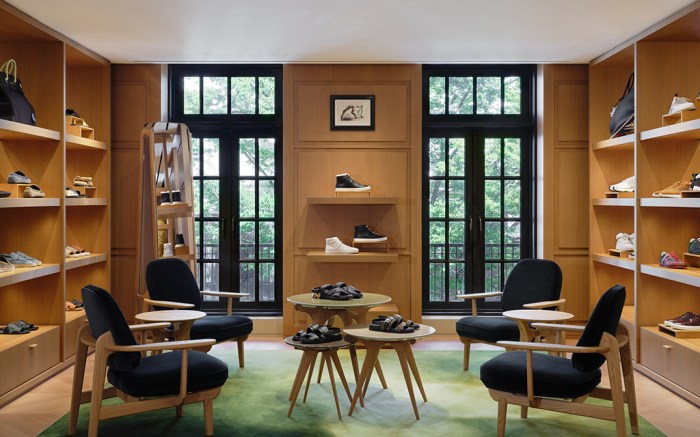What luxury slowdown? Hermès International continues to buck the trend and outpace its peers, reporting sales gained 11.3 percent at constant currency in the third quarter to 3.7 billion euros.
That puts the Birkin bag maker well ahead of other French luxury goods players, such as Kering, which reported sales slid 16 percent, and LVMH Moët Hennessy Louis Vuitton, which reported a 4.4 percent drop in revenues in the third quarter.
Hermès continues to be boosted by its resilient ultra-wealthy and loyal client base, particularly in Asia and the U.S.
Watch on FN
A slowdown in retail foot fall in China since Chinese New Year in February has been offset by an increase in the average spend, Hermès executive vice president of finance Eric du Halgouët said in a call following the release.
“It’s important to say that in China our clients are loyal, and this allows us to continue to sell our products there,” he said. Stocks particularly in handbags have stabilized due to Hermès bottom-up local ordering model.
The executive touted Hermès continued strength in China, even as competitors stumble.
“What surprised us the most over the last three quarters is probably the resilience of the group compared to other brands [and] the contrast, the resilience of Hermès, especially in greater China compared to other players in the industry,” he said. Slowdowns in handbag sales have been offset by an uptick in jewelry and ready-to-wear.
Du Halgouët noted that while footfall has slowed more markedly in Hong Kong, that is in part due to local customers traveling to mainland China and particularly Shenzhen to shop. Hermès opened a revamped store in the city this week which should capture some of that local tourist inflow.
Sales in Japan jumped 23 percent in the three months to Sept. 30, also on the strength of local clients. Tourists heading to Japan to snap up goods at lower prices due to the weak yen represents less than 10 percent of sales there, du Halgouët said. The company opened a new store in Tokyo in June, the second new store in the country this year.
The rest of the Asia region outside of Japan saw 7 percent growth, supported by sales in Korea, Singapore, Thailand and Australia, and the company opened its revamped store in Melbourne in June. A slight volume slowdown in the region has been boosted by an increase in value, he said.
With Chinese customers staying local, they are spending less abroad particularly in France and Europe. While those regions took a slight hit from fewer Chinese tourists, travelers from the U.S. and Middle East filled in those tourist gaps.
Business remained steady in the Americas, with revenues up 13 percent in Q3, roughly on par with recent quarters. Those are mostly homegrown clients, and sales are off to “a good start in October,” du Halgoüet said.
Europe excluding France was up 18 percent on the strength of tourist flows throughout the summer.
France showed a 14 percent boost in sales, despite a slight slowdown in Paris due to the Olympic games.
The company’s three stores in the capital took a hit during July and August, but that was offset by an increase in tourist inflows to the South of France. With the games in the rearview mirror, the Paris stores have recovered with sales up in the beginning of October, du Halgouët said.
Du Halgouët was keen to emphasize that the strong numbers were due to volume and not price increases. The company upped its prices about 9 percent at the beginning of the year, and anticipates another uptick at the beginning of 2025 to offset inflation, wage increases and negative currency effects.
But next year’s price increase will not be as steep. “In any case, we will not be at the level of this year, which is 9 percent. We will be lower,” said du Halgouët.
Jewelry is one category to be reevaluated, as the price of gold continues to soar.
The results handily beat analysts’ expectations of 10.5 percent growth. “We see Hermès as the best current opportunity to protect the portfolio from a difficult [fourth quarter] – suffering from a global cyclical slowdown exacerbated by structural issues in China,” said Bernstein analyst Luca Solca.
Shares were up 2 percent in midday trading.
Hermès’ exclusivity is pushing it past its rivals, even as consumers become more cautious. “Many clients recognize that Hermès products are a good investment because their high value tends to endure over time,” said Third Bridge analyst Yanmei Tang.
The watch category proved to be its weakest link, with sales down 18.2 percent in the third quarter, the sole category decline. Du Halgouët chalked some of that up to the lack of the “Crafting Time” sales event in the third quarter, which has been moved to November this year, as well as an overall drop in the category across brands.
Still, it will evaluate its designs. “There are few things that we need to deal with when it comes to our product offering, and we’ll be dealing with that shortly,” he said, indicating it will reexamine the “design and actual shape” of its timepieces.
The decline in watches is a notable contrast to its silk division, up 4 percent year-over-year, and its beauty division, which was up 10.6 percent. Both are considered aspirational categories for the company with lower price points.
Hermès opened a new silk production facility in Lyon in June to meet demand. “Even if this particular métier has suffered in China, we believe that still it has a huge potential for growth going forward,” said du Halgoüet.
Sales of leather goods were up 14 percent in the third quarter as the company introduced new handbag models, and increased its production capacity with a new factory in Riom in Central France, which opened in September, marking its 23rd leather goods factory as it has upped leathergoods production capacity by about 7 percent in the last year.
Its ready-to-wear continued to grow, with sales up 13.5 percent year-over-year, and the company’s jewelry growing 13.6 percent in the quarter, mostly on the sale of gold items. Its fine jewelry collection continued to be strong, du Halgoüet said, “but it is not the main driver of growth.”
“A faster increase in demand for non-leather categories, such as ready-to-wear and accessories…is driven by fashion trends and a rise in purchases from women and younger consumers,” said Third Bridge’s Tang.
Consolidated revenue in the first nine months of the year was up 14 percent year-over-year at constant exchange to 11.2 billion euros, despite the company taking a 242 million hit on currency fluctuations.
The company expects to take an additional hit on negative currency fluctuations in the fourth quarter, but its guidance remains unchanged, said head of investor relations Carole Dupont-Pietri.
“In the medium-term, despite the economic, geopolitical and monetary uncertainties around the world, the group confirms an ambitious goal for revenue growth at constant exchange rates,” the company said.

